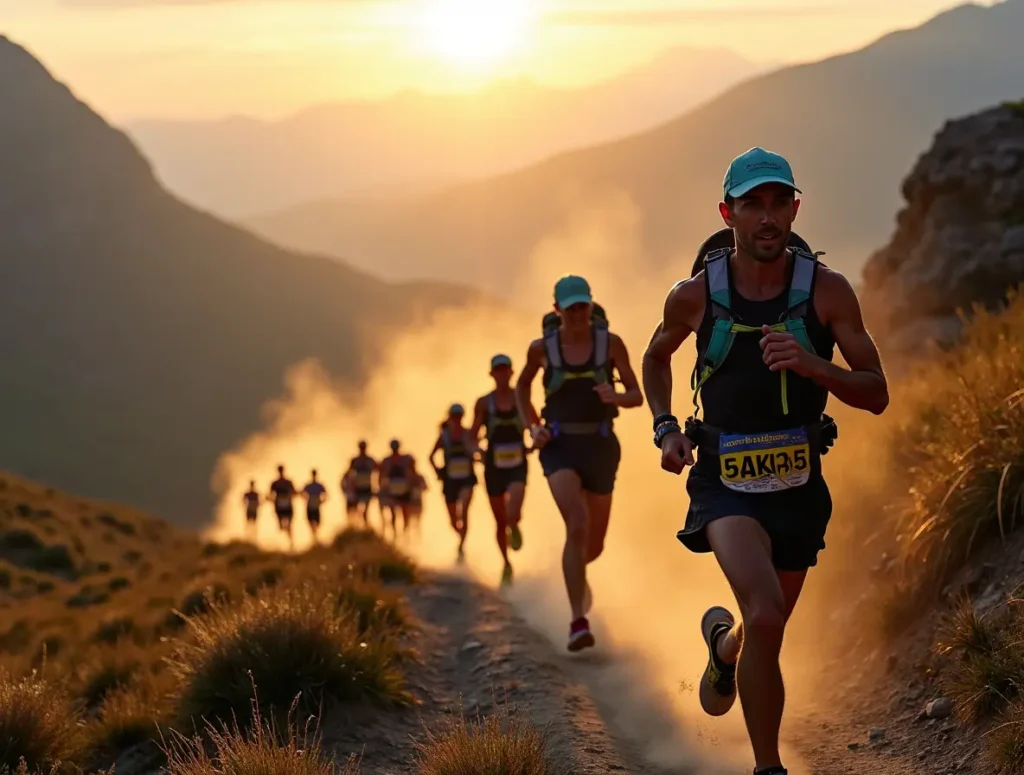Thinking about how long is an ultra marathon? You might be asking, how long does it go on? An ultra marathon is longer than the usual 26 miles 385 yards. Distances can vary, but common ones are 50 kilometers, 50 miles, 100 kilometers, and 100 miles. Knowing what an ultra marathon is key to getting ready for this tough yet fulfilling challenge.

When asking about ultra marathon length, it’s important to know the different types. These include timed races and multi-staged events. The longest races are about 100 miles, and they can be finished in under 24 hours. Whether you’re an experienced runner or new to ultra marathons, knowing the distance and type helps you prepare and reach your goals.
Exploring ultra marathons opens you up to a community of dedicated athletes. They push their limits to achieve amazing things. From the shortest 31 miles to the longest 3100 miles, each race is a unique challenge. Understanding the different distances and race types prepares you for your first ultra marathon and lets you join these inspiring athletes.
Table of Contents
Understanding Ultra Marathon Basics
Ultra marathons are races longer than 26.2 miles. They can be 50km, 100km, or even 161km long. These races need a lot of training and preparation.
The history of ultra distance running is fascinating. There are many types, like road, trail, and mountain running. What makes them different is the length, duration, and mileage. These require special training and gear.
Some key things about ultra marathons include:
- Varying distances, from 50km to 100 miles or more
- Timed events, ranging from 6 to 48 hours or more
- Different types of terrain, including road, trail, and mountain
If you’re thinking about running an ultra marathon, knowing the basics is important. This includes the race length, duration, and mileage. With the right training, you can conquer these tough races and reach your goals.
| Ultra Marathon Distance | Ultra Marathon Duration | Ultra Marathon Mileage |
|---|---|---|
| 50km | 4-6 hours | 31.1 miles |
| 100km | 8-12 hours | 62.1 miles |
| 161km (100 miles) | 14-24 hours | 100 miles |
How Long Is an Ultra Marathon: The Standard Distances
Ultra marathons can be very long, with some races over 100 miles. They start at 50 kilometers (31 miles) and can go up to 161 kilometers (100 miles) or more. These races test an athlete’s endurance, pushing them to their limits over a long time.
Some common ultra marathon distances include:
- 50 kilometers (31 miles)
- 81 kilometers (50 miles)
- 100 kilometers (62 miles)
- 161 kilometers (100 miles)
These races can range from a few hours to multiple days. The time it takes depends on the athlete’s pace and the course terrain.
The Self-Transcendence 5,000 kilometers (3,100 miles) is the longest certified road race. It takes about 40-50 days to complete. This shows the extreme distances some athletes run.
In conclusion, ultra marathons offer a range of distances and challenges. They range from 50 kilometers to 100 miles or more. The time it takes to complete them varies, testing athletes’ endurance and pushing them to their limits.
| Distance | Ultra Marathon Type | Average Completion Time |
|---|---|---|
| 50 kilometers | Short-distance ultra marathon | 4-6 hours |
| 100 kilometers | Medium-distance ultra marathon | 10-15 hours |
| 161 kilometers | Long-distance ultra marathon | 20-30 hours |
The 50K Ultra Marathon Experience
Thinking about ultra marathons? The 50K ultra marathon is a good starting point. It’s about 31 miles or 50 kilometers long. It’s a challenge for marathon runners looking to go further.
Training for a 50K ultra marathon requires careful planning. You need to think about the distance in kilometers and the terrain. The course may have big hills, and weather can also play a role.
Course Types and Terrain
50K ultra marathon courses vary a lot. Some are on trails, while others are on roads. Trail courses are often slower because they’re tougher.
Average Completion Times
How long it takes to finish a 50K ultra marathon depends on several factors. Beginners usually take 6 to 8 hours. Intermediate runners might finish in 5 to 6 hours. Experienced runners can do it in 4 to 5 hours.
| Runner Experience | Average Completion Time |
|---|---|
| Beginner | 6 to 8 hours |
| Intermediate | 5 to 6 hours |
| Experienced | 4 to 5 hours |
Exploring 50-Mile Ultra Marathons
The 50-mile ultra marathon is a big challenge, almost twice as long as a standard marathon. It pushes runners to their limits, making it both exciting and tough.
A 50-mile ultra marathon tests endurance and stamina. Runners face different terrains and weather, affecting their performance and the race length.
Notable races include the Western States Endurance Run and the Leadville Trail 100. These races are known for their tough terrain and elevation changes. Runners need to build endurance and stamina to tackle these challenges.
Here are some key statistics about ultra marathon participation:
- Total number of ultra running events analyzed: 15,451
- Total results analyzed in the study: 5,010,730
- Increase in female ultra runners over 23 years: from 14% to 23%
These stats show ultra marathons are getting more popular, with more women participating.
To run a 50-mile ultra marathon, a good training plan is key. It should include running, strength training, and recovery. Understanding the race’s demands helps runners prepare for this rewarding event.
| Ultra Marathon Distance | Number of/template | Percentage of Runners |
|---|---|---|
| 50K | 5,000 | 20% |
| 50-mile | 3,000 | 15% |
| 100K | 2,000 | 10% |
çek>
The 100K Ultra Marathon Challenge
Running 100K is a big challenge that needs a lot of prep. This race is 62.13 miles long. Runners must be ready physically, mentally, and nutritionally to do well.
To get ready for a 100K, runners need to know the physical demands. They should train regularly, increase their weekly miles, and do strength exercises. It’s also important to focus on nutrition and staying hydrated.

Mental preparation is key too. Runners need to manage fatigue, stay motivated, and keep a positive mindset. Techniques like visualization and setting goals can help. With both physical and mental prep, runners can run their best.
- 100 kilometers is equivalent to 62.13 miles
- A 100k is 49 miles longer than a half-marathon
- A 100k is 36 miles longer than a marathon
- Training for a 100k typically requires at least 5 days of running per week
| Event | Elevation Gain | Course Record (Male) | Course Record (Female) |
|---|---|---|---|
| Black Canyon 100k | 1,223 meters (4,012 ft) | 7:20 | 8:38 |
| UTMB CCC | 6,100 meters (20,013 ft) | 10:23 | 11:57 |
Conquering 100-Mile Ultra Marathons
Running 100 miles is a huge achievement that needs lots of training. The ultra marathon distance of 100 miles is very challenging, even for seasoned runners. Dean Karnazes says running 100 miles is much harder than running 50 miles.
To tackle the ultra marathon length of 100 miles, runners must be well-prepared. They need to train for at least 8 months. Before the race, they should do three 40-50 mile training runs. The ultra marathon duration can vary a lot, with some finishing in under 24 hours and others taking longer.
Here are some key statistics to consider when training for a 100-mile ultra marathon:
- Average caloric intake required during ultramarathons is 200–300 calories per hour.
- Finishing 100-mile races can vary widely, with specific personal best times stated.
- Typical ultra marathons range from 26.3 miles to over 200 miles in distance.
With the right training and preparation, runners can conquer the 100-mile ultra marathon distance. It’s crucial to focus on nutrition, hydration, and pacing. This ensures a successful finish of the ultra marathon duration.
| Ultra Marathon Distance | Average Completion Time | Caloric Intake Required |
|---|---|---|
| 50 miles | 10-12 hours | 200-300 calories per hour |
| 100 miles | 20-24 hours | 200-300 calories per hour |
Multi-Day Ultra Marathon Events
Some runners go beyond the usual by joining multi-day ultra marathons. These races can last from 24 hours to several days. The distances range from 50 kilometers to over 5,000 kilometers. This calls for a unique training and preparation approach.
The Marathon Des Sables is a famous example, covering about 250 kilometers in 6 days. The Grand to Grand Ultra is another, spanning 170 miles over 7 days. These races test not just physical endurance but also mental strength. Runners must recover between stages and manage their gear.
Some interesting facts about these events include:
- 48-hour, 72-hour, and 6-day races are common formats
- True multi-day events can stretch from 24 hours up to almost indefinitely, often ranging from 6 days to 3,100 miles or longer
- The average weight competitors carry during a self-supported multi-stage ultra marathon is approximately 10 kg
Runners need a solid training plan for these events. It should include running, walking, and rest. The pacing strategy is key, with only 20% running most of the course. 60% use a run/walk approach, and 20% walk the whole distance.
For those aiming to tackle a multi-day ultra marathon, thorough research is crucial. Understanding each event’s specific rules and requirements is vital. With the right training and preparation, runners can reach new heights in these remarkable races.
| Event | Distance | Duration |
|---|---|---|
| Marathon Des Sables | 250 km | 6 days |
| Grand to Grand Ultra | 170 miles | 7 days |
| Self-Transcendence 3100 Mile Race | 3100 miles | 52 days |
Trail vs Road Ultra Marathons
Choosing between trail and road ultra marathons is key. The distance and length vary greatly between the two. Trail events often have tough terrain, with uneven paths, hills, and obstacles.
On the other hand, road ultra marathons are on paved roads. This means a smoother and more predictable path. Yet, running long distances on hard surfaces is still a big challenge.

Trail and ultrarunning have grown by 14 percent each year for 25 years. Since March 2020, trail usage has increased by 79 percent, as reported by American Trails. This shows many runners are drawn to trail ultra marathons for their unique challenges and scenic views.
Whether you like the surprises of trail ultra marathons or the speed of road ones, knowing the differences is crucial. Think about the distance, length, and terrain to pick the right event for you. This way, you can prepare for the unique challenges and rewards of ultra marathon running.
Time-Based Ultra Marathon Events
Ultra marathons are becoming more popular, especially time-based events. These races test how long a runner can keep going, not just how far. Events range from 6 hours to 48 hours, with some runners covering over 100 miles in 24 hours.
Managing your running time is key in these races. For example, in a 24-hour race, runners might aim to cover a lot in the first 12 hours. Then, they adjust their pace to finish strong. It’s all about pacing yourself well.
Events like the Desert Solstice Track Invitational and the Self-Transcendence 3100 Mile Race are big draws. They’re for experienced runners who want to see how far they can go.
| Event | Duration | Distance |
|---|---|---|
| Desert Solstice Track Invitational | 24 hours | up to 100 miles |
| Self-Transcendence 3100 Mile Race | 52 days | 3100 BL |
Ultra Marathon Elevation Challenges
Running in ultra marathon events can be tough, especially with elevation gain. The ultra marathon distance and ultra marathon length vary, but elevation is a big challenge. It can greatly affect a runner’s performance.
The Ultra Trail du Mont Blanc (UTMB) is a 106-mile ultra marathon with big elevation challenges. It has about 33,000 feet of elevation gain. Even experienced runners find it daunting. It’s crucial to be ready for the high-altitude demands.
Here are some tips for facing ultra marathon elevation challenges:
- Acclimatize to high altitudes before the event
- Train on trails with lots of elevation gain
- Focus on nutrition and hydration to avoid dehydration and altitude sickness
Understanding and preparing for ultra marathon elevation challenges can help. It can improve performance and lower injury or exhaustion risks.
Weather Conditions and Their Impact
Weather can greatly affect your ultra marathon time and distance. Different places like deserts, arctic, and mountains offer unique challenges. Each environment has its own set of obstacles for runners.
In deserts, runners face extreme heat, which can cause dehydration and heat exhaustion. Arctic ultra events are tough due to freezing temperatures and icy roads. Mountain ultra marathons are challenging because of steep terrain and unpredictable weather.
Events like the Badwater Ultramarathon and the Hardrock 100 take place in these extreme settings. To get ready, runners need to train in similar weather. This helps them get used to the conditions they’ll face during the race.
Here are some tips for runners preparing for ultra marathons in extreme weather:
- Acclimatize to the environment by training in similar conditions
- Hydrate and fuel properly to avoid dehydration and energy depletion
- Choose the right gear, such as clothing and footwear, for the specific weather conditions
By understanding the impact of weather on ultra marathons, runners can prepare better. This helps them manage their time and distance, increasing their chances of success in these tough events.
| Ultra Marathon Event | Weather Conditions | Challenges |
|---|---|---|
| Badwater Ultramarathon | Extreme heat | Dehydration, heat exhaustion |
| Hardrock 100 | Mountainous terrain, unpredictable weather | Steep inclines, potential hypothermia |
Support Systems and Aid Stations
Participating in an ultra marathon is a big challenge. Having a good support system and aid stations can really help. These can range from 50 kilometers to 100 miles or more. Access to aid stations with food and energizing environments keeps you focused and motivated.
Aid stations offer a variety of food, like watermelon, potatoes, sandwiches, and hot meals. It’s key to plan what you expect at each aid station. This way, you can quickly get what you need, take a break, or get medical help if needed.
Here are some tips for making the most of aid stations:
- Check your hydration needs about 10-20 minutes before arriving at an aid station.
- Plan for sleep, if necessary, especially for very long events like 200/+ milers.
- Have a specific number of ‘must-do’ tasks for each aid station, typically consisting of 1 to 5 tasks depending on the race segment.
The goal is to spend as little time as possible at aid stations. With good planning and support, you can conquer even the toughest ultra marathon distances and reach your goals.
In an ultra marathon, the average 100-mile race has 10 aid stations. Spending six minutes at each can add an hour to your race time. So, it’s vital to plan ahead, stay focused, and make the most of your time at each aid station for a successful and enjoyable ultra marathon experience.
| Aid Station | Services Provided |
|---|---|
| Basic Aid Station | Food, water, and medical attention |
| Full-Service Aid Station | Food, water, medical attention, and equipment repairs |
Recovery Time After Ultra Marathons
After finishing an ultra marathon, your body needs time to heal. The ultra marathon duration and ultra marathon mileage play big roles in how long it takes. Most athletes take at least 5 days off from running, with top athletes sometimes needing 2 to 4 weeks.
The time needed to recover varies. For example, a 50k ultra marathon might need less time than a 100-mile one. It’s wise to rest for at least 1 day for every 10 miles run. Mountainous routes require even more time.
During recovery, focus on rest, hydration, and nutrition. Drink 16-20 oz of water or sports drinks every 1-2 hours. Eat a small meal with 20-30 grams of protein and 40-50 grams of carbs within 30 minutes. Also, aim for 8-10 hours of sleep the first night.
It’s important to listen to your body and not rush back to training. Don’t increase weekly mileage by more than 10% to avoid injury. Giving your body enough time to recover is key to a successful return to training and better performance in future ultra marathons.
Notable Ultra Marathon Events Worldwide
Exploring ultra marathons reveals a variety of notable events. These races show the sport’s diversity and challenge. The ultra marathon distance and length vary, but endurance and determination are key.
The World Trail Majors includes nine ultramarathons worldwide. One of them is a 103 km race. This highlights the range of ultra marathon events.
The Hong Kong 100 Ultramarathon is a notable event. It has a 5314 meter elevation gain and a 30-hour cut-off. The Black Canyon Ultra offers a 100 km and 60 km race over two days, with river and creek crossings.
These races test your physical limits and connect you with nature. They showcase the beauty of the outdoors, making them a great example of an ultra marathon.
The Badwater 135 is another iconic event. It covers 135 miles with a 13,000 foot elevation change. The Barkley Marathons feature a 63,000 foot elevation change over about 100 miles.
The Ultra-Trail du Mont-Blanc is famous for its 32,687 foot elevation gain and 46 hour and 30 minute time limit. These events showcase human endurance and the thrill of pushing limits.
Whether you’re an experienced ultra marathon runner or just starting, these events are a chance to challenge yourself. They offer unique routes, scenic environments, and demanding courses. These embody the spirit of ultra marathon running and provide unforgettable experiences.
Ultra Marathon Safety Considerations
When you run an ultra marathon, safety is key. The long ultra marathon duration and ultra marathon mileage can lead to injuries. Risks like acute-kidney injury (AKI) and overuse injuries are common. These are especially true for runs over 6 hours.
It’s important to have the right medical care and safety gear. Experts say about 90% of injuries in ultra-endurance athletes are from overuse. Changing how you race as you get older can help stay safe.
Here are some safety tips for ultra marathon runners:
- Give yourself a few months to recover between races.
- Don’t specialize in one sport too early, especially for young athletes.
- Know that endurance athletes can face health issues like atrial fibrillation.
By focusing on safety and taking the right steps, ultra marathon runners can have a safe and successful race. This is true no matter the ultra marathon duration or ultra marathon mileage.
| Safety Consideration | Recommendation |
|---|---|
| Medical Requirements | Have a medical check-up before participating in an ultra marathon |
| Emergency Protocols | Have a plan in place for emergency situations, such as dehydration or injury |
| Essential Safety Gear | Wear proper gear, such as reflective clothing and a headlamp, for visibility and safety |
Conclusion
Ultra marathons are a challenging yet rewarding endurance test. They push runners to their limits, from 50K to 100-milers. These races require a lot of physical and mental strength.
The popularity of ultra running is growing fast, with a 345% increase in participants in the last decade. But, the journey to success is tough.
To succeed in an ultra marathon, you must train hard and smart. You need to learn how to pace yourself and take care of your body and mind. Crossing the finish line is an incredible feeling.
Whether you’re experienced or new to ultra running, it can change you for the better. With hard work and the right preparation, you can join the ultra marathon community.
So, get your running shoes ready and start planning your ultra marathon adventure. The ultra marathon community is excited to welcome you. They’re ready to share the excitement of pushing human limits. The journey may be long, but the rewards are worth it.




